Wildlife are valuable natural resources and important components of a healthy ecosystem. They also provide many economic, recreational and aesthetic benefits. However, given the wrong set of circumstances, almost any species of wildlife can become a nuisance. Figures 1 to 5 are examples of potential conflicts and damage. This guide provides basic information on how to prevent and solve wildlife damage problems and includes a list of technical and educational resources.
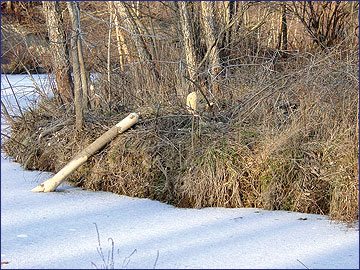
Problems caused by wildlife
Many people enjoy the benefits of wildlife, but conflicts between people and animals may occur under certain conditions. Some conflicts may be relatively minor inconveniences and are to be expected. At times, wildlife may simply be a nuisance, such as a few geese in a park, or cause minor damage that is easily tolerated, such as one or two moles in a lawn.
Other conflicts may be more serious and require action. Examples include the following:
- Losses of livestock and poultry
- Damage to crops and property
- Hazards to human health or safety
- Structural damage to personal property
- Damage to timber and other natural resources
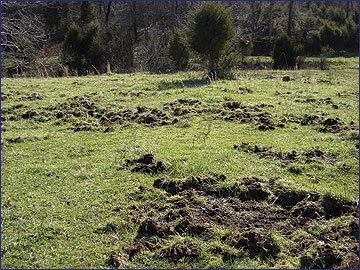
These problems can be caused by a variety of wildlife species. Predators such as coyotes may prey on sheep, calves or even pets. Rodents such as Norway rats, house mice and prairie voles can cause serious economic problems in urban areas, crops and gardens, as well as be a nuisance around the home. Flocks of birds near airports may collide with aircraft. Damage caused by beavers and muskrats may weaken levees or plug drainages. Deer can eat crops and damage landscape plantings. Birds such as starlings, blackbirds and house sparrows may be a nuisance and cause economic loss on a farm.
The presence of wildlife around your home or on your property is typically beneficial, but potential problems are caused when wildlife conflict with your goals and objectives. Landowners and homeowners need to be both tolerant of some damage caused by nuisance wildlife and proactive in taking appropriate action to prevent wildlife damage problems. A variety of scientifically valid techniques can be used to solve and control damage caused by wildlife, and technical assistance from professional wildlife damage biologists is also available. Preventing and controlling damage caused by wildlife can be costly, so consider the costs and benefits before initiating a wildlife damage management program. In most cases, an integrated pest management (IPM) strategy, which involves using multiple pest-management techniques, provides the most cost-effective method for solving wildlife damage problems.
Components of a wildlife damage management program
Successful wildlife damage management, regardless of the species involved, depends on the four basic components described below.
Problem identification and damage assessment
Selection of an appropriate damage management strategy depends on proper identification of the species causing the problem. Before you can solve a wildlife damage problem, you must identify the species causing the problem; estimate the number of animals present; assess the extent of the damage, including the amount of loss or the nature of the conflict; and evaluate biological and social factors related to the problem.
Understanding the biology and ecology of the nuisance wildlife species
Understanding the life history of the nuisance species can help you determine the best approach for resolving the problem. The biology and ecology of a species include what it eats, habitats it prefers and behaviors it exhibits, especially in relation to the type of damage observed.
Selection and application of proper damage prevention and management techniques
Once you have identified the species and learned about its biology and ecology, you can develop an appropriate damage management program. An IPM strategy is often the best way to deal with wildlife damage problems. In an IPM strategy, several control methods are combined and coordinated with other management practices and used at the same time. Often, IPM includes a combination of both short- and long-term approaches that result in a reduction of wildlife damage.
Evaluation of the management program
Periodically evaluate the management program. Assess the reduction of damage in relation to the cost of the program and the impact on the targeted species.
Prevention and control methods
Prevention and control methods or techniques used to reduce wildlife damage can be broken down into the following 10 categories:
- Exclusion of problem wildlife
- Habitat modification
- Frightening
- Repellents
- Toxicants
- Fumigants
- Trapping
- Shooting
- Nontraditional methods
- Planning for prevention of wildlife conflicts
The effectiveness of each control method depends on the biology of the species, timing, and skill of application. Some techniques that are effective for one species may be totally ineffective for other species. Also, some techniques may not be legal for control of certain wildlife. Before attempting any control method, check federal and state regulations and local ordinances that govern the use of various control methods.
Exclusion of problem wildlife
In many cases, the most economical and effective way to reduce damage may be to exclude wildlife from an area. Exclusion can be accomplished by creating physical barriers around critical areas that need to be protected. Barriers may include permanent woven-wire or electric fences, netting, hardware cloth or expanding foam over openings in structures, flashing around trees and other obstructions.
Habitat modification
Wildlife require sufficient habitat that includes food, cover, water and space to survive. Modifying a habitat to limit any or all of these components in an area can discourage wildlife nuisances.
Of these habitat components, food is the most common attractant for nuisance wildlife. In many cases, simply removing food sources discourages nuisance species from visiting an area. This habitat modification might be as simple as removing dog or cat food bowls at night to prevent raccoons from visiting. In addition, cleaning up brush piles, high grass and woodpiles to eliminate rodent habitat may decrease the number of snakes that are attracted to rodents as a food source.
Modification or elimination of cover is probably the second most important aspect in deterring or eliminating nuisance wildlife problems. Cover is a critical component of wildlife habitat that provides a variety of functions such as protection against weather and predators, as well as providing a secure place to raise young. Eliminating cover prevents many species from establishing themselves in an area. The following list describes common cover for some nuisance wildlife:

- House attics for bats and squirrels
- Woodpiles and thick vegetation for snakes and rodents
- Crawlspaces under houses for skunks, opossums and other small mammals
- Empty warehouses and overhanging structures for pigeons
- Thick, dense timber and other vegetation adjacent to agricultural crops for deer
Habitat modification that makes an area less desirable for problem wildlife should be a component of IPM aimed at reducing nuisance wildlife problems.
Frightening techniques
Frightening may work as a short-term solution for controlling some nuisance wildlife problems. These techniques involve the use of an unusual disturbance or distraction either by sight, sound or smell. Understanding the species’ biology, predator interactions and avoidance behavior is necessary when selecting and applying a frightening technique. Success of a frightening device depends largely on the species involved, how the technique is applied and timing. The following list provides examples of frightening devices and techniques:
- Visual deterrents such as effigies of owls, hawks or people
- Noise deterrents such as firecrackers, gunfire, propane cannons, sirens, barking dogs, predator calls and recordings of distress calls
- Odor deterrents such as predator urine or feces
The Wildlife Services program of the U.S. Department of Agriculture’s (USDA) Animal and Plant Health Inspection Service (APHIS) loans some frightening devices, such as propane cannons, to manage wildlife damage.
Repellents
Repellents can be useful in reducing wildlife damage in some cases, especially when combined with other damage reduction techniques. Two types of repellents can be used for wildlife:
- Contact repellents, which are applied directly to an area or a potential food item
- Area repellents, which are applied near the damaged area
Repellents deter animals by taste, smell or touch. Several companies manufacture commercial repellents for a variety of wildlife species. However, no repellent will completely eliminate wildlife damage. Most repellents are best suited for small areas, gardens and ornamental plantings. Commercial application of repellents over large areas can be costly and have varying results, making them impractical for large-scale farm and row crop use.
Many home remedies have been used to repel wildlife, however, with varied and limited success. Examples include use of blood meal, cat feces, human hair, creosote, bottled ammonia, urine and rotten eggs. These techniques have not been scientifically proven and may not deter or solve the problem.
Most repellents have limited success and must be used as part of an IPM strategy.
Toxicants
Except for rats and mice, toxicants (poisons) are not legal for controlling most nuisance wildlife species. Toxicants must be registered with the EPA and state regulatory agencies. Under certain circumstances, registered toxicants may be used by a licensed professional or government agency personnel such as USDA APHIS Wildlife Services. Be sure to follow all label restrictions and recommendations when using a toxicant in a wildlife damage management program.
Fumigants
Fumigants are poisonous gases that are most often used to control wildlife species that live in underground burrows. Several commercial fumigants are registered for certain species, such as groundhogs; these must be used according to label instructions and with caution.
Trapping
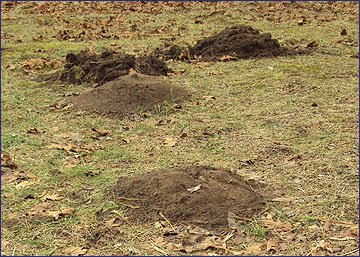
Trapping is an effective tool to remove nuisance animals from an area. According to the Wildlife Code of Missouri, property owners may trap nuisance wildlife anytime during the year or may use furbearer trappers who may trap during the established furbearer season.
Traps are classified according to design and function and can be either lethal or nonlethal. Examples of nonlethal traps include live box traps or cage traps (wire, sheet metal or wood) and foothold traps. Examples of lethal traps, which kill the animal, include body-gripping traps for beavers or muskrats; snap-traps for mice, rats and voles; and harpoon and scissor traps for moles.
Traps can be purchased from commercial sources, built at home or borrowed from the Missouri Department of Conservation (MDC) or USDA APHIS Wildlife Services. State trapping regulations dictate which types of traps are allowed for many wildlife species, such as furbearers. In addition, some traps may not be appropriate or effective for certain wildlife. Knowledge of traps and trapping, as well as wildlife behavior, is an important component of a successful trapping program. Landowners and homeowners should contact the MDC before initiating a trapping program to remove nuisance wildlife.
Shooting
Removing nuisance wildlife using a firearm or archery equipment can be an effective method of controlling their numbers and damage. As part of IPM, encouraging hunters to harvest adequate numbers of nuisance wildlife during legal hunting seasons may help reduce damage.
Hunting can be an effective approach for reducing deer depredation problems. Professional wildlife biologists can provide assistance for determining harvest strategies and recommended numbers of deer to remove. Adequate harvest of deer not only benefits the landowner by keeping potential damage to high-value crops at a minimum but also keeps the deer herd in balance with available habitat.
Deer damage depredation permits are available from the MDC for landowners with documented wildlife damage. These permits are issued by local conservation agents and allow landowners to shoot a specified number of depredating deer out of season. These permits should be used only after other damage prevention and control methods have been attempted.
Other control options to reduce wildlife damage should be tried before shooting is initiated. Before choosing shooting as an option, contact the MDC and check local government ordinances, particularly if you are near an urban area, as most cities have ordinances against shooting.
Nontraditional control methods
In some cases, nontraditional methods of controlling wildlife damage can be effective. Most of these methods evolved from trial and error of homemade approaches and remedies to solving wildlife problems. Other nontraditional techniques have become commercial and are on the market promising fast and effective results. However, some of these products provide mixed results and have not been scientifically proven to be effective.
Other home remedies, because of limited success in special circumstances, have gained a wide following as an effective approach to reducing wildlife damage. Be sure to get professional advice before using any of these materials to solve a wildlife damage problem.
Planning for prevention of wildlife conflicts
In many cases, thoughtful planning, landscaping or building design can prevent wildlife damage problems. Before building a house or commercial building, planting a garden or agricultural field, or creating an environment to attract desirable wildlife species for viewing and enjoyment, consider the potential for attracting wildlife species that might become a nuisance.
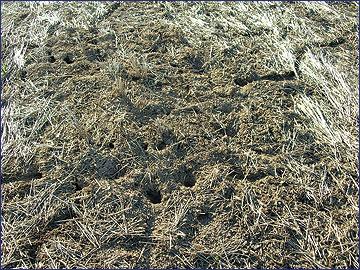
Identify wildlife in the area that are known to cause problems or have the potential to cause problems under certain conditions. Visit with neighbors, conservation agents, private pest or wildlife control operators and local wildlife enthusiasts about the potential for various species becoming a nuisance in your area.
Review plans and eliminate features that would attract nuisance wildlife. Examine your proposed land-use plans, landscaping layout or building design for their potential to provide any of the important habitat components — food, water, cover, space — that would attract nuisance wildlife in your area.
Consult a wildlife biologist for help identifying features that might attract nuisance species. Modify the plans to eliminate one or more of the desirable habitat components identified. Implementing preventive measures is much easier and more cost-effective than handling nuisance wildlife problems.
Assistance and services in Missouri
Sources of technical and educational assistance available to help prevent and solve wildlife damage problems are listed below.
Wildlife Damage Management Program, Missouri Department of Conservation
The MDC is responsible for the control, management, restoration, conservation and regulation of the bird, fish, game, forestry and all wildlife resources of the state. Since 1945, the MDC’s Wildlife Damage Management Program has served Missourians by providing information and expertise on wildlife damage prevention and control. The program has services available throughout the state and uses an extension-and-outreach approach to helping people solve wildlife damage problems.
The MDC conducts training sessions to teach landowners and property owners how to handle wildlife damage problems. Formal educational programs are often conducted cooperatively with numerous organizations and groups, and often are held at local MDC offices and MU Extension centers. In addition, training is conducted for individuals and communities experiencing wildlife damage problems. These free services are available to landowners and communities throughout the state. Traps, cable restraints, scare devices and other equipment needed to solve a particular problem are often made available at cost.
Contact either the wildlife damage biologist serving your region (Figure 6) or your local conservation agent for more information. Additional educational resources can be obtained on the Missouri Department of Conservation website.
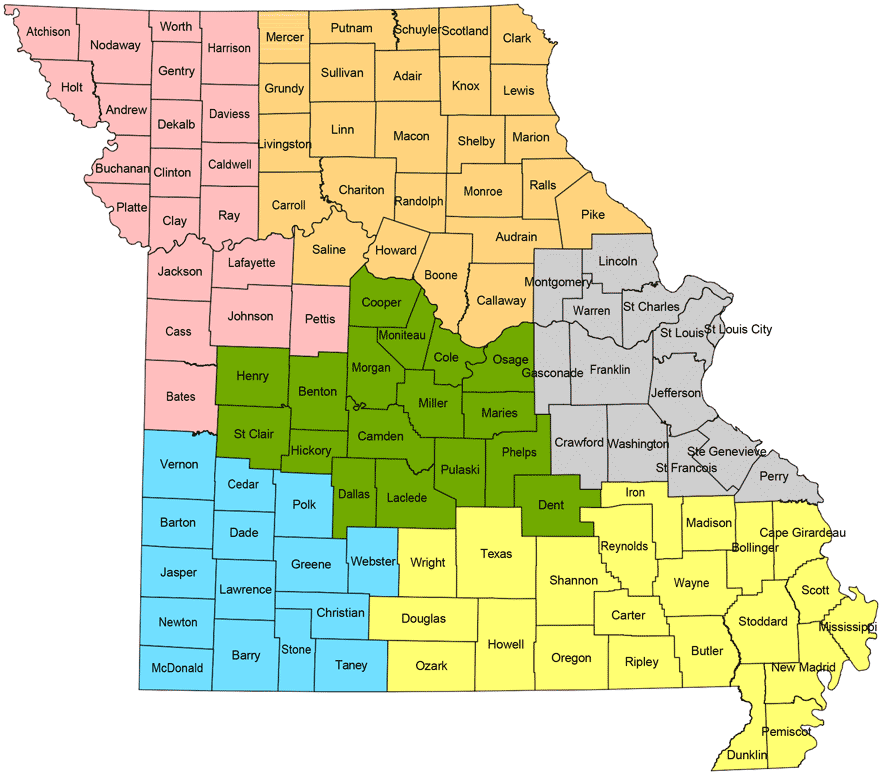
 Joseph DeBold
Joseph DeBold
Burr Oak Nature Center
1401 NW Park Rd.
Blue Springs, MO 64015-7727
816-655-6263, Ext. 1339  Daryl Damron
Daryl Damron
108 Sappington
Columbia, MO 65203-1660
573-823-5277 — Cell (P)  Dilan Simmons
Dilan Simmons
Camdenton Office
783 Thunder Mountain
Camdenton, MO 65020
573-528-3530 — Cell (W)  Tom Meister
Tom Meister
221 Lonepine Dr.
Wentzville, MO 63385
314-223-9838 — Cell (W)  Joshua Wisdom
Joshua Wisdom
2630 N. Mayfair Ave.
Springfield, MO 65803
417-380-4431 — Cell (W)  Scott McWilliams
Scott McWilliams
4007 County Road 6920
West Plains, MO 65775
417-256-6470 — Office
417-331-0180 — Cell (W)
Figure 6. The Missouri Department of Conservation has wildlife damage biologists who can help handle nuisance wildlife problems. Download the map (PDF).
USDA APHIS Wildlife Services
In Missouri, the USDA APHIS Wildlife Services program shares the primary responsibility for responding to a variety of wildlife damage issues. For example, assistance with migratory birds, aquatic rodents such as beaver or muskrats, federally protected species, and nuisance wildlife such as feral swine is provided to landowners, farmers, businesses and local governments. This assistance is provided statewide in urban and rural areas and on airports, private property and federal lands.
Assistance with wildlife damage management can be provided by calling toll-free 866-4-USDA-WS (866-487-3297). Additional educational resources can be obtained from the USDA APHIS Wildlife Damage Management Technical Series.
MU Wildlife Extension Program
University of Missouri Extension, through its network of MU Extension centers and specialists, provides educational assistance and a wide range of research-based information and publications on the prevention and control of wildlife damage. Most Missouri counties have an MU Extension center. Numerous MU Extension guides on wildlife damage management are available at your local MU extension center or on the MU Extension website.
Additional sources of information
The Internet Center for Wildlife Damage Management at the University of Nebraska is a clearinghouse for research-based information and educational materials on the prevention and control of wildlife damage. Information and a variety of technical bulletins and publications are available on the Internet Center for Wildlife Damage Management website.
Many municipalities have animal control departments that offer assistance and advice on solving wildlife damage problems, such as removing raccoons, skunks, opossums or bats from dwellings.
Private pest control operators (PCOs) specialize in solving wildlife damage problems and provide assistance to people in urban areas. For a fee, many PCOs will handle problems with Norway rats, house mice, moles, bats and nuisance birds.